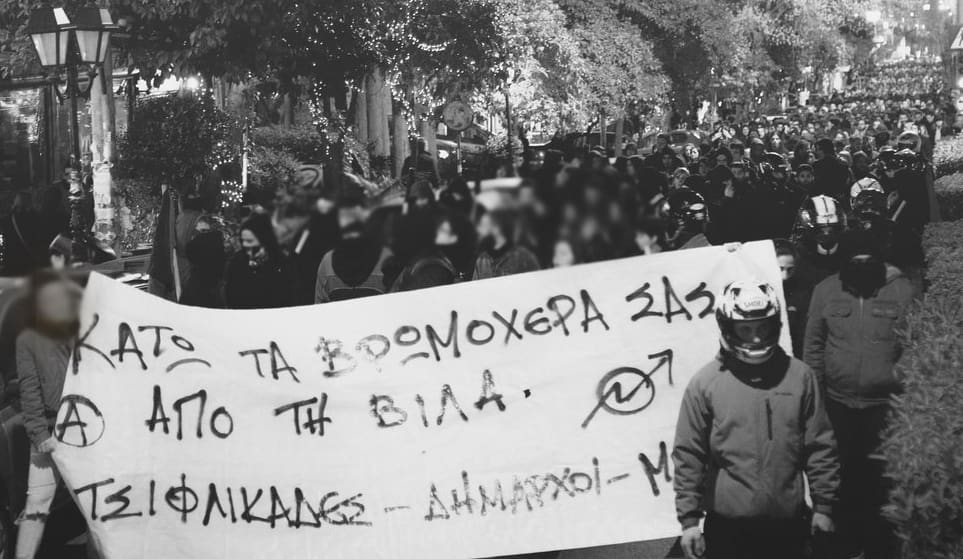AntiNote: As we lurch into winter and a new decade of crisis, let’s not forget how many people are already stranded, confined, and exposed all over the world, and how little it would actually take to show solidarity, and how much a little solidarity can mean.
Forgive this plug for one new locality-to-locality grassroots mutual aid project which our writers collective is proud to support, “Kinder World.” It is only one of many which deserve uplift in an emerging decentralized network of autonomous disaster response and humanitarian groups that together are prefiguring an alternative future of radical care, resistance, and resilience in desperate times.
Syria, refugees, and solidarity
by Leila Al Shami for Crisis Magazine
1 October 2019 (original posts)
no one leaves home unless
home is the mouth of a shark
— Warsan Shire, ‘Home’
Crossing the Mediterranean sea is fraught with danger. During 2018, an estimated 2,277 people died in their attempts to enter Europe. They were among the 141,500 refugees and migrants who reached Europe’s shores via the Mediterranean route that year. Some 10,400 of those migrants were Syrians arriving to Italy, Greece, Spain and Cyprus.
Those who survived the journey received a mixed response. On the one hand, the influx of refugees and migrants to Europe (and other countries around the globe) has provided a scapegoat for those in power to blame for their countries’ problems, and has therefore contributed to a climate of increasing xenophobia and nationalist sentiment. On the other, there’s been an outpouring of solidarity on the grassroots level, from organizing practical support in host communities, to protests that declare ‘refugees welcome.’ While such efforts are vital and should be built upon, there’s a fundamental problem with solidarity that only starts at Europe’s borders and doesn’t address the reasons why asylum seekers arrive in the first place.
Since 2011, when the Syrian state began its war against a pro-democracy uprising, over half the population has been driven from their homes. While both extremist interlopers and opposition forces have caused displacement, the main cause is the violence of the state and its foreign backers. Their actions include the relentless aerial bombardment of population centers and mass arrests of dissidents. Many monitors cite the figure of half a million killed (a figure over two years old). The country lies in ruins, with twenty-seven percent of housing and two thirds of educational and medical facilities damaged or destroyed. The breakdown of public services and destruction of the economy and livelihoods, which has thrown some eighty percent of the population into poverty, are further drivers of displacement.
Despite an increasing global consensus that the war is winding down, Syrians are still fleeing for their lives. The UN estimates that between the end of April and August of this year, more than 570,000 were displaced by the regime and Russia’s bombardment of north-western Syria. Many of these people are likely to have already been displaced multiple times. Most remain trapped inside Idlib province, sleeping out in the open, under trees, as there’s no more room in the sprawling camps. Others are amassed on the closed Syrian-Turkish border, where border guards have regularly shot, and killed, those who tried to cross.
Activists have organized largely symbolic protests, declaring that Syrians would storm the border and flee to Europe, and on 30 August hundreds did manage to break across. They hoped that the threat of thousands of brown bodies reaching Europe’s shores would spur the international community into action to stop the continuing slaughter—something which daily images of children trapped under the rubble of their destroyed homes and the sounds of their parents’ anguished screams had failed to achieve.
Despite talk of a ‘refugee crisis,’ only 11.6 percent of the global Syrian refugee population has made it to Europe. Most remain in the region, initially welcomed by neighboring countries, but now increasingly seen as a problem. In Turkey, which hosts over 3.6 million Syrian refugees—more than any other country—incitement against refugees formed a key part of recent electoral campaigns. On social media, disinformation campaigns spread hatred and division, sparking anti-Syrian protests and attacks on Syrian-owned businesses. In July, thousands of both registered and unregistered Syrian refugees, including children, were detained across the country, primarily in Istanbul, pressured into signing ‘voluntary’ repatriation forms and deported to northern Syria.
Hostility is also growing in Lebanon, where a third of the national population are refugees—the vast majority of them in a precarious situation without legal residency. A recent government decree prioritizes employment for Lebanese workers over foreigners, with reports of Syrians being dismissed from their jobs. There has been increasing racist incitement with leading politicians depicting refugees as an existential threat to Lebanon’s stability and prosperity and calling for their return to Syria, arguing the country is now ‘safe.’ Refugee encampments have been subjected to raids and evictions. More than 5,600 structures housing Syrian refugees were destroyed in Arsal by the military in June. Such hostile measures are designed to coerce Syrians to return home. In Lebanon, too, ‘voluntary’ repatriation forms have been used as a tool of forced deportation.
The idea that the war is nearing an end and Syria is now ‘safe’ for refugee return is gaining in popularity among those whose sympathy for Syrians’ continued suffering is wearing thin. One of the main promoters of this narrative is the regime itself. In September 2018, the deputy prime minister Walid Al-Moualem, reported to the United Nations General Assembly that the regime’s “war on terror is almost over,” that Syria has “become more secure and stable,” and that “doors are open for all Syrians abroad to return voluntarily and safely.” The regime uses the issue of refugee return as leverage with which it hopes to secure funding for reconstruction, money which Human Rights Watch warns will be co-opted by the regime and used to “fund its atrocities, advance its own interests, punish those perceived as opponents, and benefit those loyal to it.” Far-right groups in Europe have also seized upon the narrative of a safe, post-war return. Following visits to Damascus, German politicians from Alternative für Deutschland (AfD) and activists from Generation Identity called for the repatriation of Syrian refugees.
These calls for return must be resisted. While some Syrians are returning home due to the precarity and hostility they face in host countries, there are reports of returnees being detained by security forces on arrival. The Syrian Network for Human Rights reports that between the beginning of 2014 and August 2019, 1,916 refugees were arrested on return to Syria, including 219 children. All were detained by the regime. Of these, 638 have been forcibly disappeared and fifteen have since died under torture. A hot conflict still rages in parts of the country and even areas which are now free from daily bombardment are far from being ‘secure and stable.’
The Syrian Association for Citizens’ Dignity examined the situation in formally opposition-held areas, which returned to regime control after indiscriminate bombings and siege warfare. In most cases ‘reconciliation deals’ were agreed to under Russian auspices, in which those affiliated with the opposition were guaranteed the protection of their rights, including protection from persecution and forced recruitment into regime forces for at least six months.
These guarantees have not been honored. Numerous youth have been forcibly conscripted into regime militias and used as dispensable cannon fodder on the front lines, forced to fight against former comrades. In May, dozens of youth from Dera’a, northern Hama, and the Damascus countryside, formally opposition fighters, lost their lives on the Hama frontline, precipitating Dera’a’s largest demonstrations since 2011. Those who refused to fight on behalf of the regime have been arrested, disappeared, or killed by security services. Former members of the armed and political opposition and their families, media activists, and humanitarian workers are primarily targeted.
While the EU’s official position is that Syria remains unsafe for refugee return, the climate for refugees and migrants is increasingly hostile. EU states have implemented stricter border controls and quota systems on arrivals, stopped search and rescue operations at sea, and criminalized solidarity. Far right groups are gaining in strength as refugees and migrants are demonized as posing an existential threat to (white) Europeans. It’s vital that people continue to resist these measures, and that those fleeing war, persecution, and poverty are given safe haven and support to rebuild their lives on arrival.
If the relatively small number of refugees can be used today as an excuse for restricting freedom of movement, building walls and impenetrable borders, increasing the powers of the security state, and fomenting divisions based on race, religion, or national origin, what will tomorrow bring when the effects of climate change and ecological collapse cause vast movements of people around the globe?
Solidarity must address root causes. Increased pressure must be put on the regime to end its systematic abuse of human rights including arbitrary detention and the ongoing bombardment of population centers and civilian infrastructure. All those who have committed war crimes must be held accountable. Calls for the repatriation of refugees should be opposed unless they’re voluntary, safe, and dignified, and monitored by independent actors.
A good entry point for solidarity is to support Syrian civil society organizations, which are collectively trying to highlight the continued suffering of those who have been forcibly displaced from their homes through a campaign entitled ‘Half of Syria.’ The campaign aims to document and humanize the experience of displacement, shed light on the reasons why Syrians are still fearful to return home, and counter attempts to pressure refugees to return. Ultimately, unless people are protected from slaughter at home, they will continue to seek safety abroad.
Reprinted with the kind permission of the the author.
Featured image: Refugee tents in the Bekaa valley of Lebanon last winter, photograph posted in early January 2019. Source: Dawlaty.org (Facebook)






